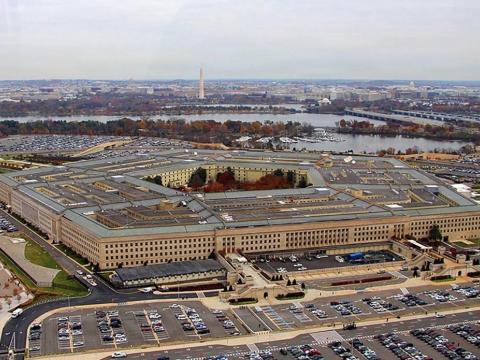DODIN Takes a Holistic Approach to Its Defense
The Joint Force Headquarters-Department of Defense Information Network (JFHQ-DODIN) is partnering with a broad base of national security organizations and industry to counter an increasing threat to U.S. forces and their operations worldwide. The JFHQ-DODIN seeks to meet this challenge with four primary focus areas that include new technologies such as automation to move data, hone commanders’ information and defend the network.
The activities of the JFHQ-DODIN were described in detail by Brig. Gen. Paul Fredenburgh III, USA, deputy commander, JFHQ-DODIN. Speaking in a keynote address on the second day of TechNet Cyber 2020, AFCEA’s virtual event being held December 1-3, the general emphasized the interlocking relationships that his organization has with others including industry.
“The equipment we use is not specially made for the Department of Defense,” he pointed out. “This is commercial equipment."
Partnerships are part of our daily operation, our near-term planning and our long-term strategic pursuits.— Brig. Gen. Paul Fredenburgh III, USA, deputy commander, JFHQ-DODIN #AFCEACyber @USDISA
— Bob Ackerman (@rkackerman) December 2, 2020
Gen. Fredenburgh added, “Partnerships are part of our daily operation, our near-term planning and our long-term strategic pursuits.”
And adversaries are on the march seeking to take advantage of that. “The bottom line is that our adversaries continue to evolve, with the capability to weaponize vulnerabilities quickly and aggressively while hiding in plain sight,” he declared. “We must challenge ourselves daily to stay to the left of intrusion—or left of click as we like to say—and we do this by outmaneuvering our adversaries in this operational domain.
“And [DODIN] is persistently under attack and threatened by cyber adversaries,” the general stated. “Our steady state is continuous competition.”
When we talk about the DODIN today, we’re talking about DOD’s cyber terrain, which is a critical component of the cyberspace warfighting domain.—Brig. Gen. Paul Fredenburgh III, USA, deputy commander, JFHQ-DODIN #AFCEACyber @USDISA
— Bob Ackerman (@rkackerman) December 2, 2020
He continued that today’s DODIN is the Defense Department’s cyber terrain, which is a critical component of the cyberspace warfighting domain. It includes all Defense Department-owned or -leased information technology infrastructure that stores, processes or transits information and data. This supports the four key functions of the Defense Department: combatant command warfighting; man, train and equip services; Defense Department intelligence activities; and business operations.
The DODIN has four operational frameworks, and the Command-Centric Operational Framework for cyber underpins all of them, he said. This refers to the authority and ability to ensure actions are synchronized rapidly in a coordinated, deliberate and purposeful manner.
With this, the DODIN has four primary strategic focus areas: to complete and promulgate the command-centric operational framework; to conduct the full scope of the secure, operate and defend mission area; to fill the capability requirements and development role; and to optimize the roles and responsibilities developing common understanding across the Defense Department.
We are continually enforcing responsibility, accountability and visibility of the ever-changing terrain.—Brig. Gen. Paul Fredenburgh III, USA, deputy commander, JFHQ-DODIN #AFCEACyber @USDISA
— Bob Ackerman (@rkackerman) December 2, 2020
Technology is not the only aspect of solutions for DODIN’s challenges, Gen. Fredenburgh allowed. “The secure, operate and defend mission is not only about technical compliance,” he declared. “It’s about readiness of systems, networks and dynamic processes. It’s about leveraging intelligence to make threat-informed decisions. It’s about anticipating needs to guide innovation that support mission assurance. It’s about training and readiness of forces working within the cyber domain. And it’s fundamentally about outmaneuvering adversaries through unity of command and the speed in execution of operations, activities, actions and investments.”
But some technologies, such as artificial intelligence, will play key roles. The general cited automation as one of the DODIN’s top interests. This encompasses everything from endpoint security, visibility of terrain from internal and external viewpoints, inspection and assessment capabilities, and decision-making and execution tools, he said. Two areas stand out, he added. One is enhancing automated capabilities that give commanders and directors real-time relevant information about the cyber terrain as it relates to the mission. The other is enhancing automated capabilities to rapidly parse the massive amount of data collected to continually strengthen the quality of information and the speed of decision making.
AI is an area that we want to mature rapidly.—Brig. Gen. Paul Fredenburgh III, USA, deputy commander, JFHQ-DODIN #AFCEACyber @USDISA
— Bob Ackerman (@rkackerman) December 2, 2020
And, once again, this involves partnerships. “We want to move forward with all of our partners who have the experience, research and expertise to enhance capability solutions in these areas,” the general offered. “Some of these capabilities no doubt already exist. It may be matter of identifying what works effectively in an expanded capacity to the level of scope and scale needed by the department, or it may require brand new capability.”





Comments